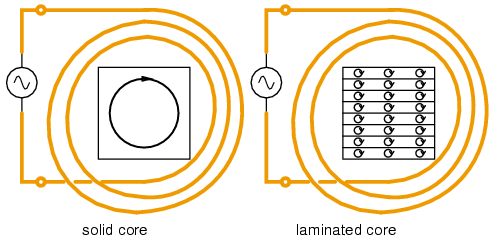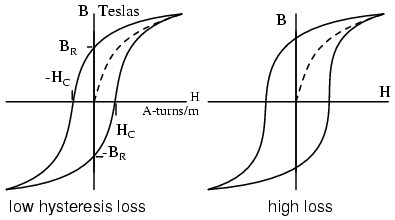| The ebook FEEE - Fundamentals of Electrical Engineering and Electronics is based on material originally written by T.R. Kuphaldt and various co-authors. For more information please read the copyright pages. |

|

Home  AC AC  AC Motors AC Motors  Hysteresis and Eddy Current Hysteresis and Eddy Current |
|






|
|
|
Hysteresis and Eddy CurrentEarly designers of AC motors encountered problems traced to losses unique to alternating current magnetics. These problems were encountered when adapting DC motors to AC operation. Though few AC motors today bear any resemblance to DC motors, these problems had to be solved before AC motors of any type could be properly designed before they were built. Both rotor and stator cores of AC motors are composed of a stack of insulated laminations. The laminations are coated with insulating varnish before stacking and bolting into the final form. Eddy currents are minimized by breaking the potential conductive loop into smaller less lossy segments below. The current loops look like shorted transformer secondary turns. The thin isolated laminations break these loops. Also, the silicon added to the alloy used in the laminations increases electrical resistance which decreases the magnitude of eddy currents.
If the laminations are made of silicon alloy grain oriented steel, hysteresis losses are minimized. Magnetic hysteresis is a lagging behind of magnetic field strength as compared to magnetizing force. If a soft iron nail is temporarily magnetized by a solenoid, one would expect the nail to lose the magnetic field once the solenoid is de-energized. However, a small amount of residual magnetization, Br due to hysteresis remains. An alternating current has to expend energy, -Hc the coercive force, in overcomming this residual magnetization before it can magnetize the core back to zero, let alone in the opposite direction. Hysteresis loss is encountered each time the polarity of the AC reverses. The loss is proportional to the area enclosed by the hysteresis loop on the B-H curve. "Soft" iron alloys have lower losses than "hard" high carbon steel alloys. Silicon grain oriented steel, 4% silicon, rolled to preferentially orient the grain or crystalline structure, has still lower losses.
Once Steinmetz's Laws of hysteresis could predict iron core losses, it was possible to design AC motors which performed as designed. This was akin to being able to design a bridge ahead of time that would not collapse once it was actually built. This knowledge of eddy current and hysteresis was first applied to building AC commutator motors similar to their DC counterparts. Today this is but a minor category of AC motors. Others invented new types of AC motors bearing little resemblance to their DC kin.
|
|
Home  AC AC  AC Motors AC Motors  Hysteresis and Eddy Current Hysteresis and Eddy Current |
|
Last Update: 2010-11-19



